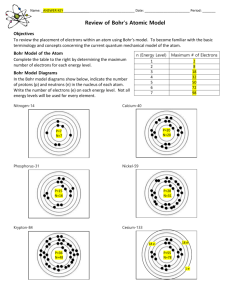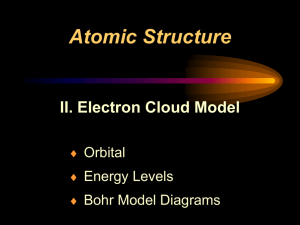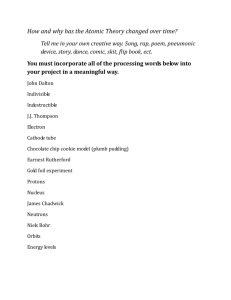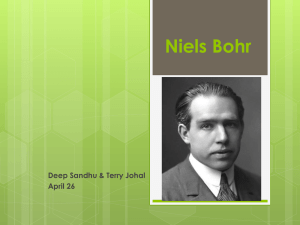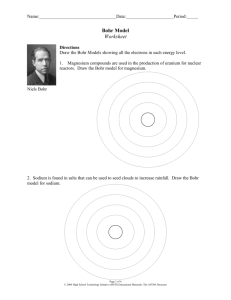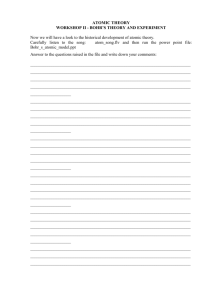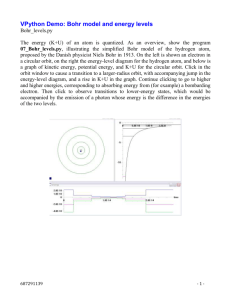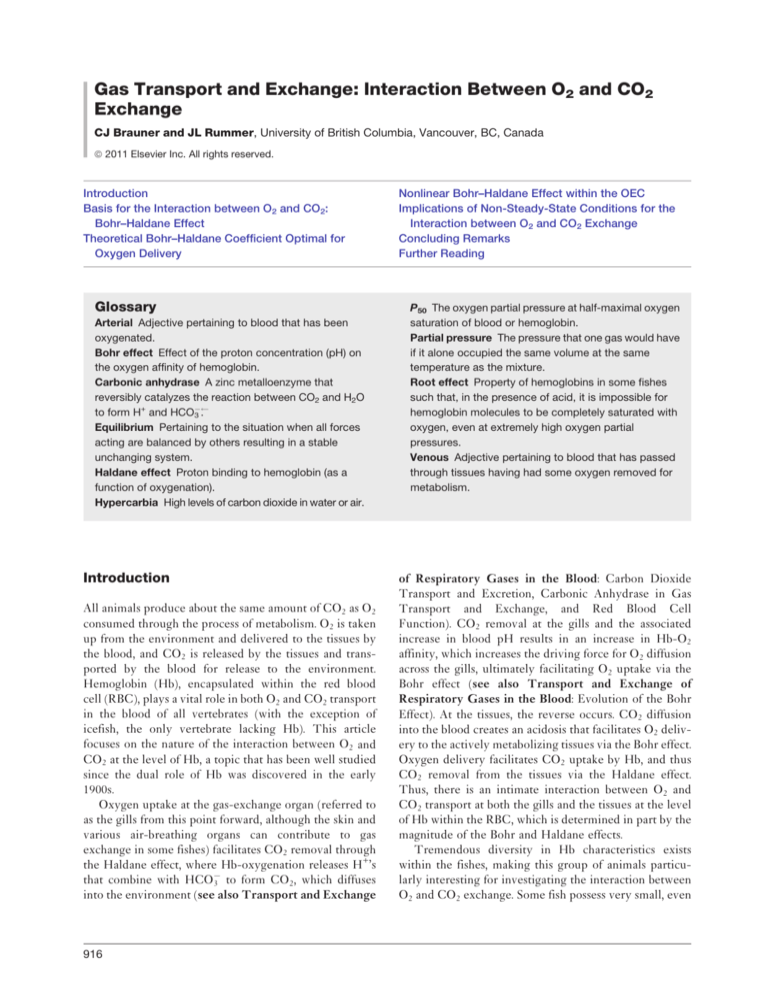
Gas Transport and Exchange: Interaction Between O2 and CO2
Exchange
CJ Brauner and JL Rummer, University of British Columbia, Vancouver, BC, Canada
ª 2011 Elsevier Inc. All rights reserved.
Introduction
Basis for the Interaction between O2 and CO2:
Bohr–Haldane Effect
Theoretical Bohr–Haldane Coefficient Optimal for
Oxygen Delivery
Glossary
Arterial Adjective pertaining to blood that has been
oxygenated.
Bohr effect Effect of the proton concentration (pH) on
the oxygen affinity of hemoglobin.
Carbonic anhydrase A zinc metalloenzyme that
reversibly catalyzes the reaction between CO2 and H2O
to form H+ and HCO�
3.
Equilibrium Pertaining to the situation when all forces
acting are balanced by others resulting in a stable
unchanging system.
Haldane effect Proton binding to hemoglobin (as a
function of oxygenation).
Hypercarbia High levels of carbon dioxide in water or air.
Introduction
All animals produce about the same amount of CO2 as O2
consumed through the process of metabolism. O2 is taken
up from the environment and delivered to the tissues by
the blood, and CO2 is released by the tissues and trans­
ported by the blood for release to the environment.
Hemoglobin (Hb), encapsulated within the red blood
cell (RBC), plays a vital role in both O2 and CO2 transport
in the blood of all vertebrates (with the exception of
icefish, the only vertebrate lacking Hb). This article
focuses on the nature of the interaction between O2 and
CO2 at the level of Hb, a topic that has been well studied
since the dual role of Hb was discovered in the early
1900s.
Oxygen uptake at the gas-exchange organ (referred to
as the gills from this point forward, although the skin and
various air-breathing organs can contribute to gas
exchange in some fishes) facilitates CO2 removal through
the Haldane effect, where Hb-oxygenation releases H+’s
that combine with HCO�
3 to form CO2, which diffuses
into the environment (see also Transport and Exchange
916
Nonlinear Bohr–Haldane Effect within the OEC
Implications of Non-Steady-State Conditions for the
Interaction between O2 and CO2 Exchange
Concluding Remarks
Further Reading
P50 The oxygen partial pressure at half-maximal oxygen
saturation of blood or hemoglobin.
Partial pressure The pressure that one gas would have
if it alone occupied the same volume at the same
temperature as the mixture.
Root effect Property of hemoglobins in some fishes
such that, in the presence of acid, it is impossible for
hemoglobin molecules to be completely saturated with
oxygen, even at extremely high oxygen partial
pressures.
Venous Adjective pertaining to blood that has passed
through tissues having had some oxygen removed for
metabolism.
of Respiratory Gases in the Blood: Carbon Dioxide
Transport and Excretion, Carbonic Anhydrase in Gas
Transport and Exchange, and Red Blood Cell
Function). CO2 removal at the gills and the associated
increase in blood pH results in an increase in Hb-O2
affinity, which increases the driving force for O2 diffusion
across the gills, ultimately facilitating O2 uptake via the
Bohr effect (see also Transport and Exchange of
Respiratory Gases in the Blood: Evolution of the Bohr
Effect). At the tissues, the reverse occurs. CO2 diffusion
into the blood creates an acidosis that facilitates O2 deliv­
ery to the actively metabolizing tissues via the Bohr effect.
Oxygen delivery facilitates CO2 uptake by Hb, and thus
CO2 removal from the tissues via the Haldane effect.
Thus, there is an intimate interaction between O2 and
CO2 transport at both the gills and the tissues at the level
of Hb within the RBC, which is determined in part by the
magnitude of the Bohr and Haldane effects.
Tremendous diversity in Hb characteristics exists
within the fishes, making this group of animals particu­
larly interesting for investigating the interaction between
O2 and CO2 exchange. Some fish possess very small, even
Transport and Exchange of Respiratory Gases in the Blood | Gas Transport and Exchange
��logP50 =�pH ¼ �Hþ
917
nonexistent Bohr and Haldane effects with relatively high
Hb-buffer values, substantially limiting the interaction
between O2 and CO2 exchange. However, the majority
of fishes (teleosts) possess large Bohr and Haldane effects
(as well as a Root effect, where oxygen-carrying capacity
of the blood is reduced at low pH) and low Hb-buffer
values, collectively resulting in tightly coupled O2 and
CO2 exchange. Furthermore, many teleost fishes exhibit a
nonlinear Bohr and Haldane effect over the region of the
oxygen-equilibrium curve (OEC), which has further
implications for the nature of the interaction between
O2 and CO2 exchange.
The point is that the Bohr and Haldane coefficients
are numerically equivalent, and will be referred to as the
Bohr–Haldane coefficient, and reported as a positive
value from this point forward. Further, this relationship
has been experimentally validated. Air-breathing ani­
mals typically have moderate Bohr–Haldane
coefficients (i.e., 0.35), while most teleosts have relatively
large Bohr–Haldane coefficients (0.5 to >1.0). The
numeric value has large implications for the nature of
the interaction between O2 and CO2 exchange in vivo, as
described in the following section.
Basis for the Interaction between O2 and
CO2: Bohr–Haldane Effect
Theoretical Bohr–Haldane Coefficient
Optimal for Oxygen Delivery
The interaction between O2 and CO2 exchange is largely
determined by the Bohr and Haldane effects as discussed
above; however, their respective magnitudes are impor­
tant in determining the nature of the interaction. The
Bohr effect describes how the affinity of Hb for O2 is
affected for a given change in the H+ concentration
(pH) of the blood. It is calculated as follows:
The potential benefit to tissue-O2 delivery associated with
the Bohr effect is quantified as the product of the pH
change associated with metabolic CO2 production during
blood transit through a tissue (arterial–venous pH change
(pHa–v)) and the magnitude of the Bohr–Haldane coeffi­
cient. A large Bohr effect is often assumed to convey a
greater benefit to tissue O2 delivery, but this will only be
true if the pH change described above is sufficient.
Associated with a large Bohr effect is a large Haldane
effect; therefore, upon deoxygenation, Hb will bind H+’s,
thereby reducing the magnitude of the pHa–v and conse­
quently the expression of the Bohr effect at the tissues. In
1983, Lapennas conducted an analysis to determine the
optimal Bohr coefficient for O2 delivery under steadystate conditions. Assuming that the pHa–v arises from tissue
CO2 production (and associated conversion to HCO�
3 and
H+) and that most animals have a tissue respiratory quo­
tient (RQ) between 0.7 and 1.0 (moles of CO2 produced per
mole of O2 consumed; see also Tissue Respiration:
Cellular Respiration), a Bohr–Haldane coefficient of
0 will result in the largest pH change within the tissues.
This would be due to the absent Haldane effect and asso­
ciated H+ binding upon deoxygenation, but would have no
effect on O2 delivery due to the lack of pH sensitivity of the
Hb (i.e., no Bohr effect). Conversely, a Bohr–Haldane
coefficient equivalent to the RQ (e.g., 1.0) will result in
no pH change due to the increased H+ binding associated
with the large Haldane effect. That is, all protons produced
by CO2 production at the tissues will be bound by Hb as O2
is released to the tissues, and, despite the presence of a pHsensitive Hb with a large Bohr effect, there may be no
benefit to O2 delivery due to the lack of pHa–v.
Furthermore, a Bohr–Haldane coefficient greater than
RQ may result in a reverse pHa–v, during blood transit,
which actually could impair tissue-O2 delivery.
Lapennas determined that the optimal Bohr coefficient
for O2 delivery under steady-state conditions (and with
Bohr coefficient ¼ – �logP50 =�pH
½1�
where P50 refers to the partial pressure of O2 (PO2) at
which 50% of the Hb molecules are oxygenated.
The Haldane effect describes how the affinity of Hb
for H+’s and CO2 is affected by changes in Hb-O2 satura­
tion. It is calculated as follows:
Haldane coefficient ¼ �Hþ
+
½2�
+
where �H refers to the moles of H ’s released per mole
of O2 bound to Hb.
Although the Bohr and Haldane effects are often dis­
cussed in terms of their respective roles relative to O2 and
CO2 dynamics at the level of the Hb, they are actually
mirror images of the same phenomenon. While the Bohr
effect describes changes in Hb-O2 affinity that arise from
a change in H+ concentration, the Haldane effect
describes the changes in Hb–H+ affinity that arise from
a change in PO2, and therefore Hb-O2 saturation. Thus,
the Bohr and Haldane effects are linked functions, as has
been recognized by the classic Wyman linkage equation:
ðlogPO2 =pHÞY ¼ ðHþ =Y ÞpH
½3�
+
where Y refers to Hb-O2 saturation and H refers to the
number of protons bound per heme molecule. Assuming
that the shape of the OEC is symmetrical and H+ release
is linear with Hb-binding O2, which is often the case in
vertebrates (but not always, as described below in section
Nonlinear Bohr–Haldane Effect), the linkage equation is
often reduced to the following:
½4�
918
Transport and Exchange of Respiratory Gases in the Blood | Gas Transport and Exchange
many assumptions) is 0.5 � RQ. This represents a com­
promise between pH sensitivity of the Hb and the
resulting pH change that occurs during capillary blood
transit. Because many air-breathing vertebrates have
Bohr–Haldane coefficients of 0.35 (which is very close to
optimal if RQ is assumed to be 0.7), he concluded that
their Hbs have been optimized for O2 delivery (Figure 1).
Given that most teleost fish possess Bohr–Haldane coeffi­
cients much greater than 0.5 � RQ (see also Transport
and Exchange of Respiratory Gases in the Blood:
Evolution of the Bohr Effect), it has been assumed that,
under steady-state conditions in most tissues, fish Hbs may
be optimized for CO2 transport and acid–base homeostasis
rather than tissue-O2 delivery. This clearly does not apply
to the unique structures within the swimbladder and eye,
where there exists a tremendous potential for generating
and localizing an acidosis, which in conjunction with
the Root effect and associated large Bohr–Haldane coeffi­
cients generates incredibly high O2 tensions (see also
Transport and Exchange of Respiratory Gases in the
Blood: Root Effect: Molecular Basis, Evolution of the Root
Effect and Rete Systems and Root Effect: Root Effect
RQ = 1.0
Δlog P50
RQ = 0.7
A
0
0.2
0.4
B
0.6
0.8
1.0
Bohr−Haldane coefficient
Figure 1 The optimal Bohr–Haldane coefficient: theoretical
Bohr shifts, as described by a change in P50 (�log P50) during
blood capillary transit using two respiratory quotients (RQs). Units
have been omitted intentionally from the y-axis, because the
magnitude of this response will vary by species, depending on Hb
buffer values. A and B indicate Bohr–Haldane coefficients optimal
for O2 delivery for RQ values of 0.7 and 1.0, respectively. Each
curve crosses the x-axis at both zero and the RQ, two points at
which Lapennas suggests there will be no benefit to O2 delivery
associated with the Bohr–Haldane effect. Modified from Lapennas
GN (1983) The magnitude of the Bohr coefficient: Optimal for
oxygen delivery. Respiration Physiology 54(2): 161–172.
Definition, Functional Role in Oxygen Delivery to the
Eye and Swimbladder). However, in other tissues, given
Lapennas’ assumptions, a very large Bohr–Haldane coeffi­
cient would not benefit tissue-oxygen delivery. Despite
Lapennas’ many assumptions, his analyses serve as an
interesting framework for hypothesizing how different
Bohr–Haldane coefficients within and between species
may influence the interaction between O2 and CO2
exchange in vivo.
Nonlinear Bohr–Haldane Effect within
the OEC
The assumption for many models depicting vertebrate Hb
function is that the magnitude of the Bohr–Haldane coeffi­
cient is relatively constant across the entire OEC. Although
this may be true for most air-breathing vertebrates, it is
not the case in several fish species, where most of the
Bohr–Haldane effect occurs in the upper reaches of the
OEC (between 50% and 100% Hb-O2 saturation) with
very little expression below 50% Hb-O2 saturation. The
nonlinear Bohr–Haldane effect is typically associated with
species that possess Root-effect Hbs, perhaps suggesting that
nonlinearity is common among teleosts. When fish use dif­
ferent regions of the OEC for gas exchange in vivo,
implications for a nonlinear Bohr–Haldane effect influen­
cing the interaction between O2 and CO2 exchange become
interesting.
The entire Bohr–Haldane effect may be exploited in
resting fish, where venous Hb–O2 saturation levels
rarely fall below 50%. In resting rainbow trout
Oncorhynchus mykiss, the Bohr–Haldane coefficient cal­
culated over the region of the OEC used in vivo is
approximately 1.0, a value close to RQ. Therefore,
CO2 excretion at the gills and CO2 and acid–base
transport at the tissues will be maintained because Hb
will bind all H+’s released from the tissues during O2
delivery. However, when fish are forced to swim, the
arterial–venous O2 difference increases, requiring a
greater region of the OEC to be used for gas exchange.
The magnitude of the Bohr–Haldane coefficient calcu­
lated over the region of the OEC used for gas exchange
during exercise is reduced to a value of 0.4–0.5, remark­
ably close to the value deemed optimal for O2 delivery
by Lapennas. Accordingly, during periods of increased
activity and therefore muscle-O2 demand, the nonlinear
Bohr–Haldane effect may be important for optimizing
O2 delivery. Thus, the nature of the interaction
between O2 and CO2 exchange, if a nonlinear Bohr–
Haldane effect is present, changes with exercise inten­
sity and the region of the OEC exploited for gas
exchange.
Transport and Exchange of Respiratory Gases in the Blood | Gas Transport and Exchange
Implications of Non-Steady-State
Conditions for the Interaction between O2
and CO2 Exchange
Most of the discussion to this point has assumed steadystate, equilibrium conditions; however, it is unlikely that
such conditions exist in vivo, because gas exchange con­
sists of a complex combination of blood flow, boundary
layers, chemical reactions, and diffusion. For example, if
CO2 from the tissues diffuses into the blood faster than O2
diffuses to the tissues, a large Bohr–Haldane coefficient
could facilitate O2 delivery during blood capillary transit.
The only way to determine whether this occurs in vivo is
by direct measurement, which is very difficult. In the only
published study to date where this has been conducted in
fish, PO2 was measured in real time via an optode
implanted in the red muscle of resting rainbow trout.
Results indicate a much higher tissue PO2 than in mam­
mals. Despite an in vivo Bohr–Haldane coefficient of
1.0 under resting conditions (far greater than the optimal
value determined as described above), it could be that
general O2 delivery is enhanced in rainbow trout, and
perhaps other fish species. Clearly, additional studies of
this nature are required to investigate this further.
In fish, the greatest disequilibrium state at the level of the
RBC is likely associated with catecholamine-stimulated
Na+/H+ exchange. During stress, or when Hb-O2 saturation
falls below 50%, metabolic CO2 and H+ production may be
elevated. Catecholamines such as adrenaline and noradrena­
line are released into the circulation and bind to
�-adrenergic receptors on the RBC membrane. Through
adenylate cyclase, which activates 39,59-cyclic monopho­
sphate (cAMP), the �-adrenergic Na+/H+ exchange
(�NHE) on the RBC membrane is activated. The carbonic
anhydrase (CA)-catalyzed hydration of CO2 inside the RBC
produces H+ and HCO�
3 ; the former are removed in
exchange for Na+ via the �NHE to restore pHi and there­
fore Hb-O2 affinity, but at the cost of decreasing plasma pH.
�
The HCO�
3 is removed via anion exchange for Cl . The
+
+
resulting osmotic gradient activates the Na , K pump, and
osmotically obliged water enters the RBC, causing the cell to
swell (see also Transport and Exchange of Respiratory
Gases in the Blood: Carbon Dioxide Transport and
Excretion and Red Blood Cell Function). This process is
thought to have evolved to protect O2 uptake at the respira­
tory surface during a general acidosis in species possessing
Root-effect Hbs, where an acidosis drastically decreases not
only Hb’s affinity but also carrying capacity for O2.
However, this is also an example of a disequlibrium state
where O2 and CO2 transport dynamics do not follow steadystate models.
The adrenergically activated �NHE elevates pHi but
only in the absence of plasma-accessible CA. If CA were
accessible to the plasma, this would short-circuit the RBC
919
�NHE, because H+’s would combine with HCO�
3 to form
CO2 and back-diffuse into the RBC, decreasing pHi
(Figure 2). Fish lack plasma-accessible CA at the gills
and thus adrenergically activated �NHE protects O2
uptake at the respiratory surface; however, CA may be
plasma accessible in some tissues, where the CA IV iso­
form (see also Transport and Exchange of Respiratory
Gases in the Blood: Carbonic Anhydrase in Gas
Transport and Exchange) is bound to endothelial cells
and plasma oriented. When the �NHE is activated during
stress, and blood passes through capillaries possessing CA,
the RBC �NHE is short-circuited, resulting in a much
larger pHa–v than which would otherwise occur, greatly
facilitating O2 delivery to the tissues.
Short-circuiting of RBC �NHE has been validated
in vitro. When CA is added to adrenergically stimulated,
mildly acidified RBCs in a closed system, it results in a
rapid acidification of RBC pHi and a dramatic increase in
PO2. Accordingly, short-circuiting of RBC �NHE in vivo
could potentially have large effects. In rainbow trout
implanted with an O2 optode in red muscle, which allows
real-time tissue PO2 monitoring, inducing a mild acid–
base disturbance by exposing fish to elevated environ­
mental CO2 levels (hypercarbia) results in a significant
increase in tissue PO2. However, when plasma-accessible
CA is subsequently inhibited following the addition of a
non-membrane-permeable CA inhibitor to the blood, the
hypercarbia-induced increase in tissue PO2 is abolished,
indicating that short-circuiting of RBC �NHE may be
operational in vivo and may greatly facilitate O2 delivery.
Therefore, although rainbow trout have a large Bohr–
Haldane effect, a large pHa–v in the RBC may occur via
exploiting disequilibrium states in vivo. Furthermore, this
system would operate with every pass through the tissues,
effectively harnessing the general acidosis to create a
RBC pHa–v, which will be localized to tissues that possess
plasma-accessible CA.
Concluding Remarks
The intricate relationship between O2 and CO2 exchange
has been described in past models that assume equilibrium
conditions, which link the Bohr–Haldane relationship to
the RQ in order to make predictions as to optimal O2
delivery or CO2 transport and acid–base homeostasis.
However, equilibrium conditions probably never occur
in vivo. In addition, teleosts possess a large Bohr–Haldane
coefficient, which according to Lapennas’ theory may be
detrimental to tissue O2 delivery. Yet, real-time measure­
ments confirm elevated muscle PO2 in rainbow trout,
suggesting that a mechanism is in place to enhance O2
delivery in fish. Teleosts’ unique Root-effect Hbs convey
a great potential for O2 delivery, and possessing a nonlinear
Bohr–Haldane effect allows different parts of the OEC to
920
Transport and Exchange of Respiratory Gases in the Blood | Gas Transport and Exchange
Catecholamines
3
11
4
O2 + Hb-H+
O2
CO2 + H2O
2
Tissue
1
Hb-O2 + H+
CO2
CA
HCO3− + H+
CI− HCO3− Na+ H+
3Na+
8
10
H2O
CO2 + H2O
CA
5
6
7
2K+
cAMP
ATP
− Na+
CI− HCO3
H+
H2CO3
9
Figure 2 Short-circuiting the �-adrenergic response at the red blood cell: With the advent of an acidosis or when metabolic CO2
production is high, the red blood cell (RBC) intracellular pH (pHi) can decrease substantially. Metabolic CO2 enters the RBC (1) and is
+
catalyzed by carbonic anhydrase (CA) to form HCO�
3 and H (2), the latter of which will bind hemoglobin (Hb), thus releasing O2.
Catecholamines such as adrenaline and noradrenaline are released into the circulation to bind to receptors on the RBC membrane (3),
activating adenlylate cyclase and 39,59-cyclic monophosphate (cAMP) (4), which activates the Na+, H+ exchanger (�NHE) (5). As protons
(H+) are removed from the RBC in exchange for Na+, pHi increases and Hb–O2 affinity is restored. Bicarbonate (HCO�
3 ) is removed from the
RBC in exchange for Cl� via the anion exchanger (6), resulting in an osmotic gradient that activates the Na+, K+ pump (7). Osmotically
obliged water enters the cell (8) resulting in RBC swelling. As long as �NHE rates are high and CA is not accessible to the plasma, this
results in an increase in RBC pHi. However if CA is plasma accessible (9), which may occur in the tissues, H+ and HCO�
3 removed from the
RBC would be catalyzed to form CO2 that would back-diffuse into the RBC (10). This would short-circuit the original protective function of
the �NHE mechanism and favor O2 unloading from the Hb (11), which in the case of Root-effect Hbs would be substantial, creating
enhanced O2 delivery localized to tissues possessing plasma-accessible CA.
be utilized under different conditions. Indeed, the potential
exists, and during non-steady-state conditions such as
intense exercise or hypoxia exposure, adrenergic stimula­
tion of the RBC �NHE creates the acid–base
disequilibrium needed to maximize this potential.
Plasma-accessible CA in select locations within metabolizing tissue may be localizing the acidosis by short-circuiting
the �NHE, therefore facilitating O2 delivery to tissues to a
much greater degree than that in air-breathing vertebrates.
Root-effect Hbs evolved long before the eye and swimbladder retia, structures typically associated with the
unique pH-sensitive Hb, suggesting a general use for
such great O2 delivery potential (see also Transport and
Exchange of Respiratory Gases in the Blood: Root
Effect: Molecular Basis, Evolution of the Root Effect and
Rete Systems). Along with the increase in and nonlinearity
of the Bohr–Haldane effect, teleosts appear to greatly
facilitate O2 transport with only moderate whole-blood
pH changes.
See also: Tissue Respiration: Cellular Respiration.
Transport and Exchange of Respiratory Gases in the
Blood: Carbonic Anhydrase in Gas Transport and
Exchange; Carbon Dioxide Transport and Excretion;
Evolution of the Bohr Effect; Hemoglobin; Red Blood Cell
Function; Root Effect: Molecular Basis, Evolution of the
Root Effect and Rete Systems; Root Effect: Root Effect
Definition, Functional Role in Oxygen Delivery to the Eye
and Swimbladder.
Further Reading
Berenbrink M, Koldkjaer P, Kepp O, and Cossins AR (2005) Evolution of
oxygen secretion in fishes and the emergence of a complex
physiological system. Science 307(5716): 1752–1757.
Brauner CJ and Randall DJ (1998) The linkage between oxygen and
carbon dioxide transport. In: Perry SF and Tufts B (eds.) Fish
Physiology, Volume 17: Fish Respiration, pp. 283–319. New York:
Academic Press.
Brauner CJ, Thorarensen H, Gallagher P, Farrell AP, and Randall DJ
(2000) The interaction between O2 and CO2 exchange in rainbow
trout during graded sustained exercise. Respiration Physiology
119: 83–96.
Brauner CJ, Wang T, Val AL, and Jensen FB (2001) Non-linear release
of Bohr protons with haemoglobin–oxygenation in the blood of two
teleost fishes: Carp (Cyprinus carpio) and tambaqui (Colossoma
macropomum). Fish Physiology and Biochemistry 24(2): 97–104.
Jensen FB (1989) Hydrogen ion equilibria in fish haemoglobins. Journal
of Experimental Biology 143: 225–234.
Lapennas GN (1983) The magnitude of the Bohr coefficient: Optimal for
oxygen delivery. Respiration Physiology 54(2): 161–172.
McKenzie DJ, Wong S, Randall DJ, et al. (2004) The effects of sustained
exercise and hypoxia upon oxygen tensions in the red muscle of
rainbow trout. Journal of Experimental Biology 207(21): 3629–3637.
Nikinmaa M (1990) Vertebrate Red Cells: Adaptations of Function to
Respiratory Requirements. Berlin: Springer.
Tufts B and Perry SF (1998) Carbon dioxide transport and excretion.
In: Perry SF and Tufts B (eds.) Fish Physiology, Volume 17: Fish
Respiration, pp. 229–281. New York: Academic Press.
Wyman J (1973) Linked functions and reciprocal effects in haemoglobin:
A second look. Advanced Protein Chemistry 19: 223–286.

